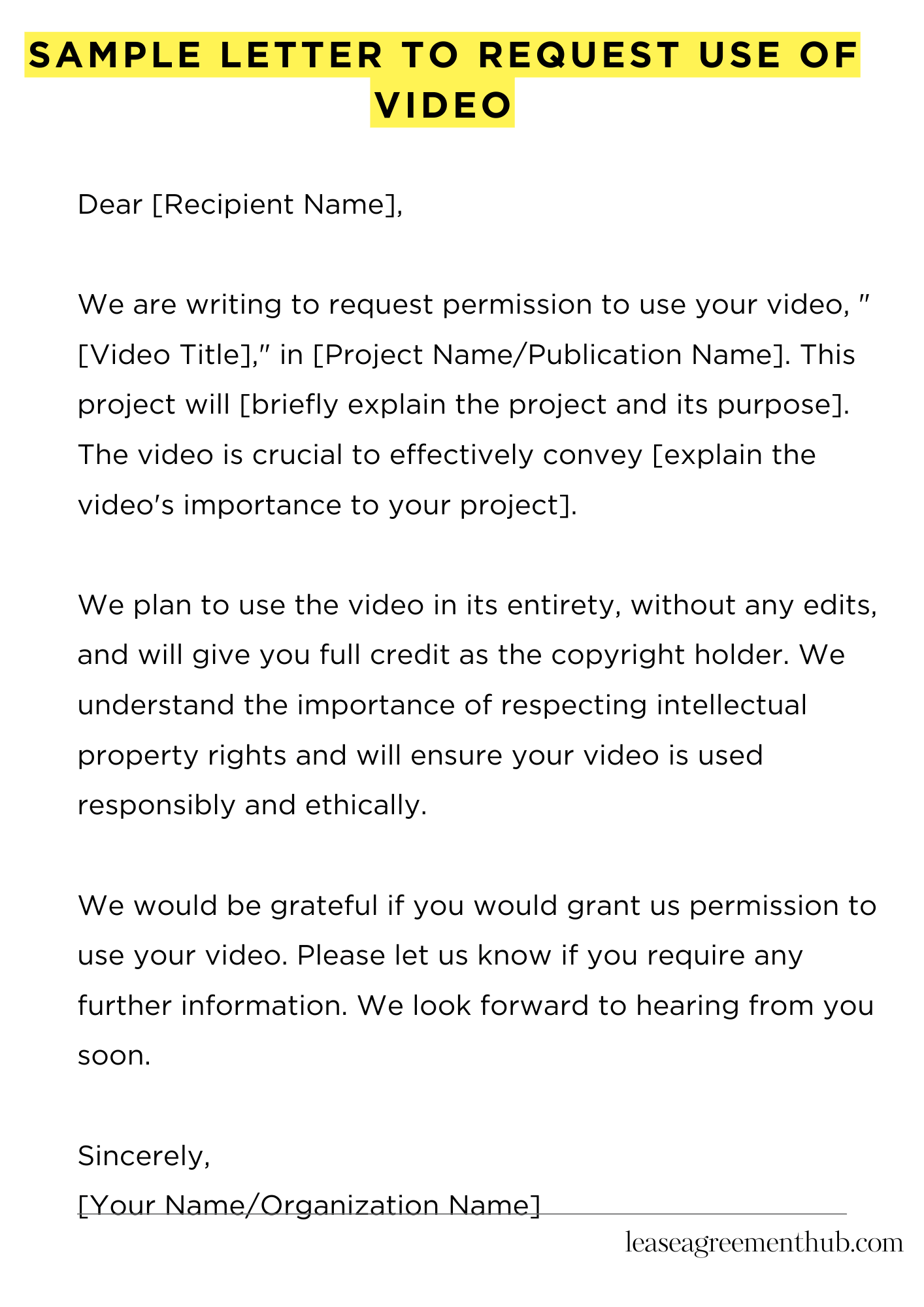Need to use someone’s video? A request letter is essential. It’s a polite way to ask for permission. It shows you’re respectful of their work.
This article gives you ready-made letter examples. We’ll provide templates for different situations. You can easily adapt them to your needs.
These samples will save you time and effort. Copy, paste, and personalize. Writing a professional request becomes super easy.
sample letter to request use of video
[Your Name/Organization Name]
[Your Address]
[Your Phone Number]
[Your Email Address]
[Date]
[Recipient Name/Organization Name]
[Recipient Address]
Dear [Recipient Name],
We are writing to request permission to use your video, “[Video Title],” in [Project Name/Publication Name]. This project will [briefly explain the project and its purpose]. The video is crucial to effectively convey [explain the video’s importance to your project].
We plan to use the video in its entirety, without any edits, and will give you full credit as the copyright holder. We understand the importance of respecting intellectual property rights and will ensure your video is used responsibly and ethically. Our intended audience is [describe your target audience]. We anticipate a reach of approximately [number] viewers.
We would be grateful if you would grant us permission to use your video. Please let us know if you require any further information. We look forward to hearing from you soon.
Sincerely,
[Your Name/Organization Name]

How to Write a Sample Letter to Request Use of Video
Understanding the Importance of Formal Requests
Procuring permission is paramount. Using copyrighted video material without authorization can lead to legal ramifications. A well-crafted letter demonstrates professionalism and respect for intellectual property. It lays the groundwork for a positive and potentially fruitful collaboration. It also protects you from future disputes.
Identifying the Video and Copyright Holder
Before initiating contact, meticulously ascertain the precise video and its copyright holder. This might be an individual, a corporation, or a distribution platform. Thorough research will ensure your request reaches the appropriate party, expediting the process. Utilize online resources and databases for comprehensive identification.
Crafting a Compelling Subject Line
Your subject line should be succinct yet informative. A vague subject line risks being overlooked. Something like “Permission Request: [Video Title]” clearly communicates your intent. This concision facilitates efficient processing and ensures your letter receives prompt attention.
Structuring Your Request Clearly and Concisely
Begin by introducing yourself and your affiliation. Clearly articulate your purpose for using the video. Specify how you intend to use the footage, including the context, platform, and target audience. Be specific about the duration and sections of the video you wish to utilize. Transparency is key to building trust.
Proposing Compensation or Acknowledgment
While not always obligatory, offering compensation or prominent acknowledgment demonstrates goodwill. This can be monetary compensation, attribution within your project, or a reciprocal agreement. Such gestures increase the likelihood of a favorable response. Consider the value the video brings to your project.
Providing Contact Information and Follow-up
Include your complete contact information: email address, phone number, and mailing address. This enables the copyright holder to reach you easily. Indicate a timeframe for your follow-up. This demonstrates proactive engagement and underscores your seriousness.
Proofreading and Sending Your Letter
Before sending, scrupulously proofread your letter for any grammatical errors or typographical infelicities. A polished letter reflects professionalism. Choose a suitable delivery method, whether email or traditional mail, depending on the recipient’s preference and the formality of the situation. A well-presented letter enhances your credibility.
FAQs about sample letter to request use of video
Requesting permission to use video content requires careful consideration of legal and ethical implications. A well-crafted letter significantly improves your chances of obtaining the necessary authorization.
What information should I include in my video usage request letter?
Your letter should clearly identify the video you wish to use, specifying the title, creator (if known), and where you found it. State your intended use (e.g., educational purposes, marketing campaign), the platform where it will be shown, and the geographic reach. Crucially, you need to specify the duration of the intended use and whether you plan on making any modifications to the video. Finally, always include your contact information.
How do I address the copyright holder when I don’t know who they are?
If the copyright holder is unknown, thorough research is crucial. Try reverse image searching, examining video metadata, and searching online databases. If you can’t identify the owner after reasonable effort, you might consider including a statement in your letter explaining your diligent search and requesting assistance in locating the copyright holder. If you can’t find them consider if your use falls under fair use.
What should I offer in exchange for permission to use the video?
While not always required, offering something in return can strengthen your request. This could range from providing credit to the video creator, including a link to their website or social media profile, to offering a small fee depending on the commercial value of the video and the length of use. The specific offer should be tailored to the situation and your budget.
How formal should my letter be?
Maintain a professional and respectful tone throughout your letter. Use clear and concise language, avoiding jargon. While the level of formality depends on your relationship with the copyright holder (if known), a formal letter is generally advisable, especially when dealing with a commercial entity or significant public figure.
What if the copyright holder refuses my request?
Respect their decision. If they refuse, accept their response gracefully and don’t attempt to use the video without permission. You could try to explore alternative options to achieve your goals, or if your intended use is legitimate under fair use consider this option.
Related: